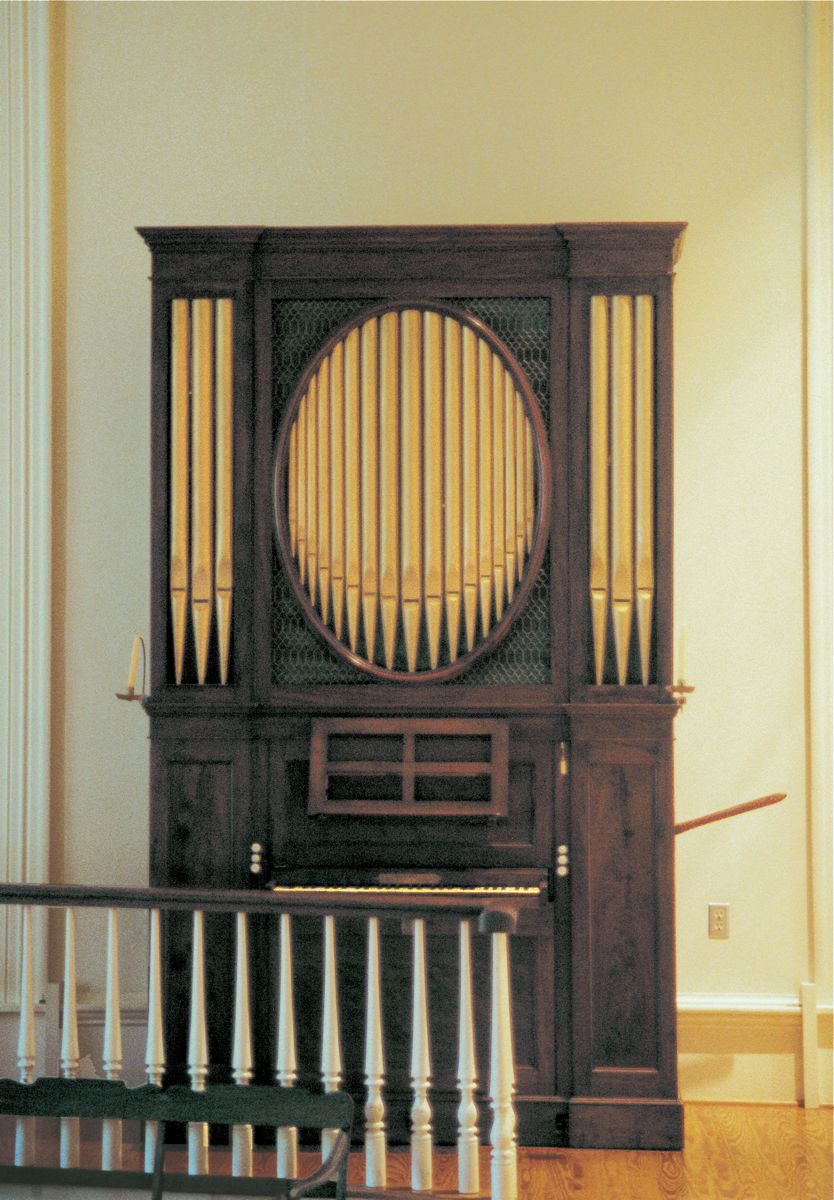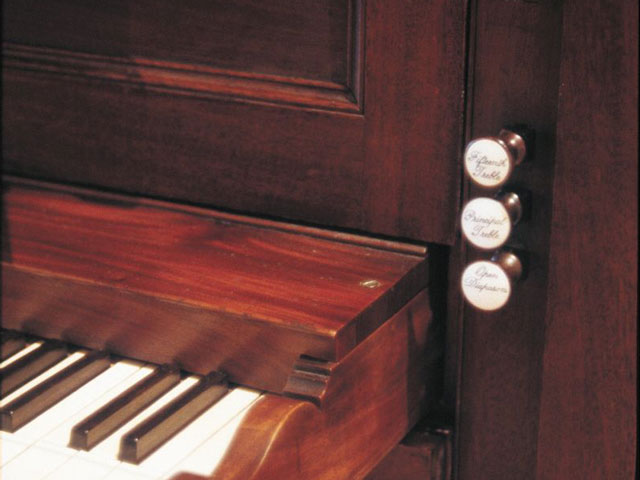| 8' | Open Diapason (metal) |
| 8' | Stopped Diapason (wood) |
| 4' | Principal (divides at c3 (middle C)) metal |
| 2' | Principal (divides at c3 (middle C)) metal |
History
Samuel Green, organbuilder to King George III in the second half of the 18th century, was born in September of 1740, baptized on September 21 and died September 14, 1796, aged 56 years. He built or rebuilt more than 60 organs, larger church organs as well as smaller fiber organs as is found here. This Samuel Green organ is one of 13 surviving chamber organs. It has four ranks of pipes and six stops. It was built in Isleworth, Middlesex, England c. 1795. The case is mahogany with a shellac finish, the secondary wood is pine. The original cloth behind the facade was of green silk. A remnant of the original material was used to choose the cloth now hanging in the case. The wooden, flat-backed dummy facade pipes were originally gold leafed, though are now covered with gold paint. The stopknobs are turned out of rosewood and the faces are engraved in ivory.
The organ possesses a shining movement which allows the organist to cancel the Principal and Fifteenth stops by simply pressing down and holding the left iron foot pedal. This foot pedal controls an extra set of sliders which are moved into the off position when holding the pedal down. When the pedal is released, the sliders are moved back into the open position and the pipes will play once again.
The organ has remained hand pumped throughout its life and contains its original parallel rise bellows. Samuel Green is the organbuilder credited with the invention of this type of bellows. The wood used to make the bottom board, top board and ribs is of pine. It has been releathered with sheepskin, the material Samuel Green used. The organbuilder provided three ways to wind the bellows. While playing, the organist can pump the bellows him/herself or relocate the iron pedal to the right side so an assistant can pump (thereby having the person available to turn music pages, or help turning stops on and off). The third method is by having an assistant pump using the mahogany wood pump handle located on the right hand side of the case. This pump handle can be removed when not in use and the small "door" closed leapfrog the case side free from any protrusions. The pulley on the front of the case where the "tell tail" hangs (to tell the organist/pumper how empty the bellows is getting) is turned out of ivory. The pulley above the pump handle on the side of the case is brass.
The keyboard frame is mahogany, the keys are of lime, the natural platings are ivory, scored with two small lines and filled with ink, the sharps are ebony and the key nosings are mahogany, with a light coat of shellac over them. It has received some new ivories over its lifetime. The keyboard slides completely into the case when not in use.
The pipework is all original. It is unfortunate that at some time in the organ's past the metal pipes were cut in an effort to raise the pitch of the organ and bring it from is original temperament to equal temperament. This is the one and only item that has ever been altered in the organ. It was strongly felt that the organ would only receive a proper restoration if only it is made to be heard as Samuel Green conceived the instrument. To this end, a temporary solution was worked out. Slide tuners have been added to an the metal pipes and using the wood pipes as a guide, the pitch and temperament have been set closer to the original. The pitch is about 436 c.p.s. at 74 degrees and the temperament has been set at fifth comma meantone. The original tuning of Green's chamber organ from 1787 has been used as a guide to deciding this temperament.
The organ was found in pristine original condition at the Kent-DeLord Museum in Plattsburgh, NY. It was purchased by the Metropolitan Museum of Art in New York City. After a brief time in storage, the firm of R.J. Brunner & Co. Organbuilders, Silver Spring, PA restored the organ.
Photographs courtesy of William T. Van Pelt 2002-05-01


